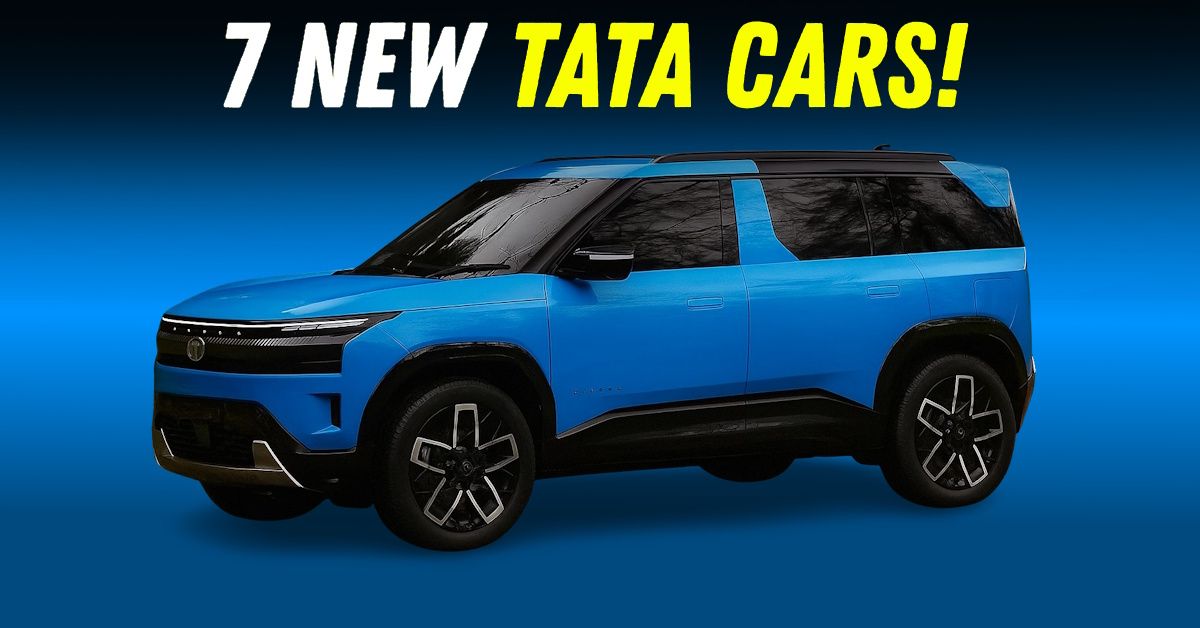7 New Tata Cars Lined Up For India


Tata Motors has announced its most ambitious product blitz yet. By the end of this decade, the company aims to add seven entirely new models to its passenger vehicle line-up, signalling a decisive push to consolidate its position in both the internal combustion engine (ICE) and electric vehicle (EV) segments.
This strategic roadmap was outlined during the company's recent Investor Day, where Tata also confirmed that 23 facelifts and product updates are in the works. With these additions, the brand's portfolio will swell from the current eight models to over fifteen by FY2030.
The move comes at a time when competition from Hyundai, Mahindra, and MG is growing, and Tata is looking to expand its presence across body styles and segments.
Leading this product revival is the much-awaited comeback of the Sierra. Once a cult favourite, the Sierra is now being reimagined for the 2020s, not just as a nostalgic tribute but as a technologically advanced, forward-looking SUV.
The Sierra will come in both ICE and EV avatars, with the petrol version likely to debut first. Test mules have been spotted on Indian roads sporting features such as a triple-screen layout, and the electric version is expected to offer high levels of connectivity, safety and performance.
Tata showcased the new Sierra at the Bharat Mobility Global Expo 2025, where it made a strong impression as a symbol of the brand’s product reinvention.
Equally significant is the upcoming Avinya range, a brand-new EV sub-brand that will see two all-electric models hit the market. Built on the EMA (Electric Modular Architecture) platform jointly developed with Jaguar Land Rover, these vehicles will represent Tata's entry into the premium EV territory.
The first Avinya model, codenamed P1, is expected to be priced upwards of ₹35 lakh and positioned as a rival to global EV nameplates. These models are also likely to lead Tata’s global ambitions in the electric space, supported by cutting-edge software-defined vehicle platforms.
The recently launched Harrier.ev has already begun rolling out in India as a premium electric SUV offering a 500+ km range and dual-motor (QWD) capabilities. The model is expected to account for a fifth of all Harrier sales, showing growing consumer trust in high-end EVs from local manufacturers.
Meanwhile, the Punch.ev has democratised EV access in the compact SUV space, offering advanced features like V2V charging and a 10.25-inch infotainment cluster at an affordable price.
With these launches, Tata is actively repositioning itself from being merely a first mover in the EV segment to a full-spectrum player offering products across body styles and budgets.
Tata’s EV push is underpinned by some staggering numbers. The company delivered nearly 74,000 electric vehicles in FY24 and currently commands a 73 percent share in India’s EV market. With over 2 lakh Tata EVs now on Indian roads, the company claims to have saved more than 7 lakh tonnes of CO2 emissions.
Looking ahead, Tata wants EVs to comprise 20 percent of its total sales by FY27, rising to 30 percent by FY30. To support this, it is expanding its charging infrastructure from 8,000 stations to over 40,000 within the next year. This includes fast-charging networks on highways, in cities, and in residential areas, addressing a key barrier to EV adoption.
The company has also built an integrated EV ecosystem through partnerships across the Tata Group. Tata Power handles charging infrastructure, Tata AutoComp assembles battery packs, Tata Chemicals works on lithium-ion cells, and TCS supports the tech backbone. This closed-loop synergy gives Tata a major cost and speed advantage over many competitors.
The seven new models are only part of the transformation. Tata has planned 23 refreshes to existing nameplates, ranging from facelifts and safety updates to new engines and improved infotainment.
These updates aim to keep existing models fresh, competitive, and aligned with evolving buyer expectations. Expect to see tech upgrades, new powertrains like flex-fuel and hydrogen ICE, and software-led enhancements across the board.
Also on the horizon is a potential MPV offering, a gap in Tata's current line-up, as demand for spacious family vehicles continues to grow.
To support this ambitious roadmap, Tata Motors has earmarked ₹33,000 to ₹35,000 crore over the next five years, with a significant chunk going towards EV and software-defined vehicle development. R&D spending alone rose 45 percent in FY24, reaching ₹29,398 crore. That’s more than the combined R&D spend of India’s top 30 listed private companies, a clear indication of the company's long-term intent.
Tata is also expanding manufacturing capacity with a ₹9,000 crore plant coming up in Tamil Nadu. This facility will build both Tata and Jaguar Land Rover models, positioning India as a global production hub. With direct employment for 5,000 people and high-end capabilities, the plant is central to Tata’s export ambitions and diversification strategy.
The roadmap is robust, the targets are ambitious, and the intent is clear. But the key lies in execution. Managing quality, production timelines, and service consistency across such a large product rollout will not be easy. As Tata enters a new chapter, its ability to scale efficiently while maintaining the reliability and trust it has built in recent years will determine whether this bold bet pays off.
For buyers, though, the next few years will be exciting. Whether you're looking for a nostalgic SUV, a next-gen EV, or a feature-packed family vehicle, Tata’s upcoming line-up promises something for everyone. The only question is, can it deliver on all fronts?